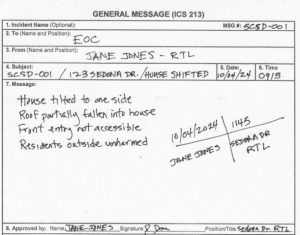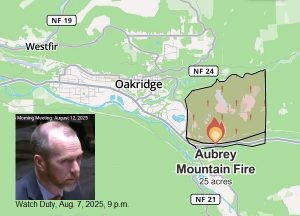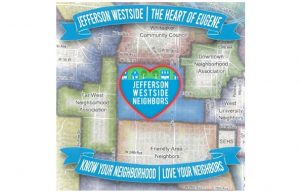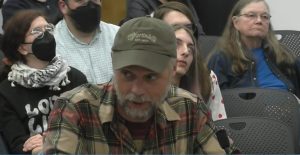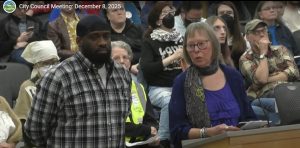Lane County offers recommendation on local access roads
9 min read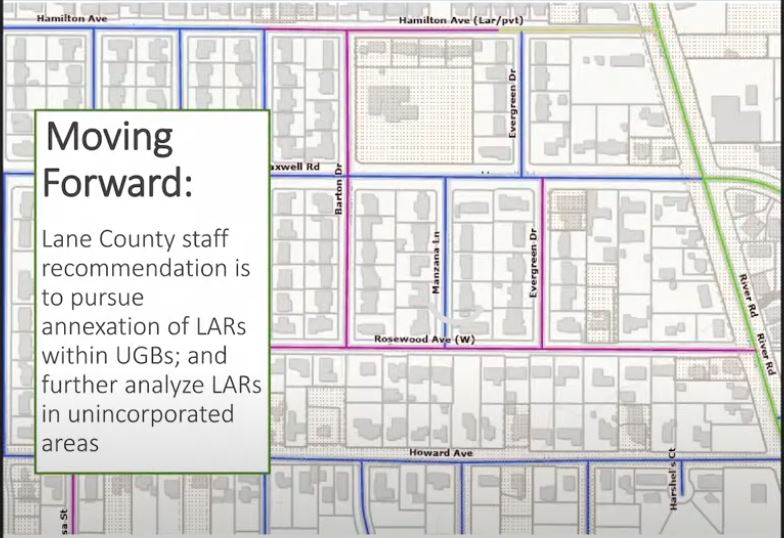
Lane County Public Works says changes to Oregon statutes in 1981 restricted counties from spending money on local access roads. Now, decades later, property owners are asking county commissioners for help. During a work session April 29, Lane County’s Transportation Planning Supervisor Cassidy Mills:
[00:00:22] Cassidy Mills (Lane County Public Works): I’ll just share a little bit about the history and challenges of local access roads.
[00:00:26] Most LARs were built between 60 and 100 years ago, primarily by the private sector to gain access to property divisions and development. LARs are a mechanism developers have historically used to provide access to subdivided property at a lower cost than building to a county road standard.
[00:00:46] Presenter: Commissioner Pat Farr:
[00:00:48] Commissioner Pat Farr: You said that originally, 100 years or so, people built LARs because it was cheaper. They could build a house at the end of the road or several houses at the end of the road, cheaper than building to county standards. So the homeowner at that point saved a lot of money by not building to county standards.
[00:01:04] Presenter: They did, but decades later we are now seeing the long-term results. Cassidy Mills:
[00:01:10] Cassidy Mills: As a result, most of these roads are substandard with respect to county’s road design standards for county roads.
[00:01:17] It has been long enough since LARs were constructed that there is substantial deferred maintenance on many of the LARs.
[00:01:24] Presenter: Without regular maintenance, roads can reach a point where they start to degrade rapidly. Property owners seeing the need for road work soon learn what it means to live on a local access road. During public comment April 29, Joshua Kielas:
[00:01:39] Joshua Kielas (Property owner on LAR): Hi, Joshua Kielas from River Road neighborhood. I wanted to use this moment to speak to you from the perspective of a homeowner on one of those streets.
[00:01:48] While I have no doubt this issue will be better known and understood going forward, those of us who currently own property on local access roads made our purchases without knowing what we were getting into. Nobody told us we were buying houses on public roads that are not maintained by the public.
[00:02:07] We were not informed that because we happen to live along these roads, we would need to become knowledgeable in their maintenance, somehow organize all of our neighbors, and personally pay for their repair.
[00:02:20] We don’t own or have any control over these streets, so we can’t charge tolls or put up gates. We’re in an untenable situation of the county’s making, and it’s very frustrating.
[00:02:32] I’m here to tell you that there is no world in which all the neighbors on a given street, including mine, will be able to agree on a course of action, much less afford it. I’ve recently tried, and it’s not happening. We’re stuck.
[00:02:47] At this time you have hundreds and hundreds of constituents, fellow community members, road tax payers, who are unjustly dealing with this burden.
[00:02:56] In our hands, there is no clear solution and the problem is only going to get worse over time. In your hands, it’s a problem that is solvable.
[00:03:08] So I’m urging the county to step up and take on the responsibility for maintenance because it’s the right thing to do.
[00:03:16] Presenter: During the work session April 29, Road Maintenance Manager Orin Schumacher:
[00:03:20] Orin Schumacher (Lane County Public Works): I will note that this is not a new topic of discussion. It is a reoccurring topic of discussion all the way back to records I could find in 1972 across the county…
[00:03:29] So local access roads are confusing for us and for a lot of people. They are public roads but they are not county roads or state roads or city streets. They are public roads. I continue to hear that these are city LARs or county LARs. They are defined by ORS statutes and they are LARs—with no prefix. They’re local access roads defined by the state through ORS, which is listed there as ORS 368.001.
[00:03:55] Presenter: The 1981 legislature said counties can only spend money on local access roads in an emergency or when three conditions are met. Cassidy Mills:
[00:04:07] Cassidy Mills: Ultimately, the state of Oregon limits how counties can spend funds on local access roads. As such, we do not maintain local access roads, and ORS limits this expenditure.
[00:04:18] Oregon Revised Statute 368.031: A county governing body shall spend county monies on the local access road, only if it determines that the work is an emergency or if the county road official recommends the expenditure, the public use of the road justifies the expenditure proposed, and the county governing body enacts an order or resolution authorizing the work and designating the work to be either a single project or a continuing program. The important caveat is that it has to be A, B and C in order for county dollars to be expended.
[00:04:54] Presenter: And the county road fund is stretched thin right now. Engineering and Construction Services Manager, Sasha Vartanian:
[00:05:02] Sasha Vartanian (Lane County Public Works): Our expenses are rising faster than the road fund is supporting it. In fact, so much so that we and other counties across the state anticipate a 60% shortfall for pavement preservation projects and over a 70% shortfall for capital construction projects. We don’t have enough money to support the infrastructure we have. That’s really the short summary there. We’re going to be dependent on our reserves.
[00:05:32] Presenter: The only upside is that county roads are still in good shape. Describing the Pavement Condition Index (PCI), County Administrator Steve Mokrohisky:
[00:05:42] Steve Mokrohisky (Lane County, administrator): The reason we have such a high Pavement Condition Index is we were always reliant on timber funding. We had a bunch of timber funding to build all these wonderful roads and we’re still living with the benefits of that investment that happened 30 or more years ago.
[00:06:01] But if we don’t continue to invest, we have the problem now of having that state funding that’s dropped off, we don’t have the timber funding or the Secure Rural Schools federal funding that historically has funded that.
[00:06:12] So we’re just going to see a steady decline and then a complete drop-off. It will be, you know, ‘death by 1,000 cuts’ is sort of the concern there.
[00:06:20] The reliance on timber funding historically and the abundance that we had at one time, that’s put us in a good position today. But that won’t last if we don’t invest in it.
[00:06:28] Presenter: With more details on the Pavement Condition Index, Road Maintenance Manager Orin Schumacher:
[00:06:34] Orin Schumacher: Lane County’s PCI has been maintained phenomenally. While we’ve been holding about an 81—which is really good across the state, we were number one in those condition assessments—we will anticipate dropping into a 76 PCI by 2028, even with the current funding we have now. So that’s with us throwing everything we have, all the tools and dollars, at our road system, we’re still going to start declining to a 76.
[00:06:59] Once you get down below the 70s, that’s where things really start transitioning towards rehab, rebuild, reconstruct projects, which by square yard are just thousands apart from the preservation option. So that’s the concern we’re looking at with our existing road system as it is, without additional thousands of dollars.
[00:07:16] Presenter: The county staff has prepared a recommendation. Cassidy Mills:
[00:07:20] Cassidy Mills: We recognize that LARs present a major funding dilemma both for the county and for the residents served by these roads. Road repairs are often extremely costly and can be beyond the financial means of the adjacent property owners and they are currently beyond Lane County’s road fund capacity.
[00:07:37] Given the historical and current gap between funding needs and funding available, and the policy direction of the Metro plan for transportation services to be provided by the cities of Eugene Springfield, staff recommend conducting further analysis to support those cities in identifying LARs that are suitable for annexation within urban growth boundaries, resulting in them becoming city streets.
[00:07:59] And analysis for LARs outside of urban growth boundaries that may be suitable candidates for becoming county roads.
[00:08:06] Presenter: Commissioner Pat Farr:
[00:08:08] Commissioner Pat Farr: I think the discussion regarding a close relationship between city government and county government to find a strategy, because in the early 2000s there was a huge push by property owners in River Road and Santa Clara to not annex. In fact, remember the signs out there.
[00:08:24] Yeah, and some of those signs are still there. But most of the people who were against it then aren’t there anymore. So it’s a new generation of landowners out there. So we may have a new landscape to work with in terms of people being receptive.
[00:08:38] But that being said, city of Eugene is not going to fix it once it’s annexed, necessarily. They’ll do it within their means. And a case in point is back in ’96 or ’97, we made a conscious decision to not grade alleys in Eugene.
[00:08:56] Drive down alleys in Eugene, people living there, their front doors are on the alley, and the potholes are, I mean, you could fish in the potholes.
[00:09:03] And, you know, so the city of Eugene doesn’t have a fantastic record, and they don’t have cash hanging on trees to do this, you know, but they don’t have a fantastic record of fixing what they already have, let alone what they take on.
[00:09:17] Once the city annexes, it doesn’t necessarily improve the road. I’ll give you an example. You know, we’ll use Bethel Annex, like mid-60s, go drive down Irwin, East and West Irwin, and North Way, it’s a loop, still not improved. And this is, let’s see, ‘65, something like that. I mean, it’s quite a few years later.
[00:09:38] So it doesn’t, it’s not a panacea for getting roads improved because other things they have do come into play, and ultimately the landowners, the property owners are the ones that pay for the improvements if it’s unimproved road when the city annexes.
[00:09:51] And the city doesn’t say, ‘Hey, we got money, we’ll pay for it’” and say, ‘Hey, you got money, you pay for it.’ And if they don’t, then you have East and West Irwin Way, and you have the Bethel Triangle. Go there.
[00:10:05] Dove Lane, which is behind Willamette High School, and I cite Bethel, I cite alleys, and you can cite other areas of the city where they’re, you know, the city just kind of, you know, I’m on the verge of going down a really bad hole here, so let’s just leave it at that.
[00:10:22] The city doesn’t have the resources to fix things once they do acquire it. So it would take a great deal of concerted effort between the people living there, between the governments to make it happen in a way that satisfies people, in a timely fashion that satisfies people.
[00:10:37] Presenter: Commissioner Laurie Trieger:
[00:10:39] Commissioner Laurie Trieger: And the one note I had that I haven’t heard any response to is this issue of seller disclosure requirement, and enforcement for that, because that’s the piece that as I understood from the readings should be happening and isn’t.
[00:10:52] Presenter: Cassidy Mills:
[00:10:53] Cassidy Mills: That’s accurate. So we just were recently successful in getting working with our GIS team and Lane Council of Governments when you go into Zillow or whatever, it’s what feeds the property information. And so now there is a section on that that says whether or not the property potentially takes access from a local access road. And then if you click on that, it goes to the definition of what a local access road is and maintenance responsibility.
[00:11:24] Presenter: Public Works Director Dan Hurley:
[00:11:26] Dan Hurley (Lane County Public Works, director): While local access roads are a problem across the county, most of the energy right now is in the River Road/Santa Clara area. And with our recommendation that we should pursue annexation on these roads with the city, I’m wondering if you would be interested in, the next time you have a joint elective officials meeting, if we could put this on the agenda and we could work up some proposals that you might want float with the city officials and see if we can make some traction.
[00:11:54] Presenter: Commissioners agree to start working closely with the city towards annexation that will turn local access roads into city streets. They’ll discuss it during their next joint meeting.
This story produced by John Q for Whole Community News. No voice goes unheard on KEPW 97.3, Eugene’s PeaceWorks community radio.
UPDATE (May 4, 2025): Clarify that Joshua Kielas spoke during the public comment period rather than the work session, and emphasize that the significance of the 1981 ORS changes for property owners involved restricting how counties can spend monies on local access roads.
